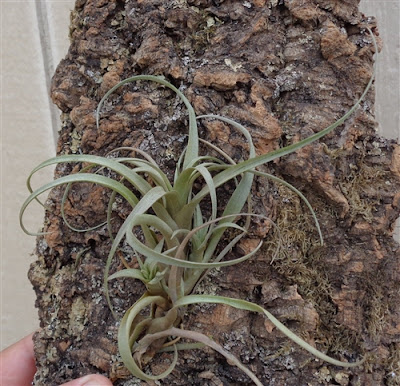Tillandsia nana is native to South America, especially southern Peru and Bolivia. It is found up to altitudes close to 3500 meters above sea level.
Tillandsia nana, also called as Tillandsia calocephala, is a species of the genus Tillandsia. This species was described by John Gilbert Baker in 1889.
IDENTIFY TILLANDSIA NANA AIR PLANT
Tillandsia nana is native to South America, especially southern Peru and Bolivia. It is found up to altitudes close to 3500 meters above sea level.
It is a medium sized, caulescent, epiphytic or saxicolous species which reaching 30 cm in size with many, very flexible leaves that arranged in a helix. Sheaths very weakly marked with brownish scales at the apex, in the prolongation of the limb which is triangular and often canaliculate.
This air plant bloom from the bipinnate, sometimes simple, globose in appearance inflorescence that borne by a short peduncle, with several short, flat and narrow ears. The bracts of the flowering stem and the primary bracts are similar to the leaves. The floral bracts are scaly, veined and imbricate. The non-fragrant flowers are non-tubular, 1 to 2 cm long, pink sometimes red or purplish. The stamens and pistil are included.
TILLANDSIA NANA AIR PLANT CARE AND CULTURE
Cultural information should only be used as a guide, and should be to be adapted to suit you. Your physical location; where you grow your plants, how much time you have to devote to their care, and many other factors, will need to be taken into account. Only then can you decide on the cultural methods that best suit you and your plants.
Light:
Tillandsia nana requires good light, avoiding full sun in the summer afternoon. Place the plant very close to a window indoors in winter and preferably out in mid-shade in the summer.
Temperature:
The required temperature ranging from 10 to 32°C. Get it early enough in the fall if you grow it outside, so that it does not face night temperatures below 3 ° C, especially if it is wet. The plants can faced temperatures close to 0 ° C (sheltered and dry) for a few hours without damage.
Humidity:
This air plant need the moderate level of humidity. Good aeration is required, the plant must dry quickly (in less than an hour).
Substrate, growing media and repotting:
Tillandsia nana refer to be mounted on a solid substrate that does not retain water. You can glue the plant directly to the surface with a strong adhesive, or you can wire the plant to the base. Don't cover the base of the plant with moss or it may rot. It can be grown on almost any imaginable decorative mount, including shells, rocks, slate, driftwood, etc.
Watering:
Two or three times a week in summer, one or two times a week in winter according to the luminosity and the ambient humidity. Obviously when it rains and if you grow it outside, it counts as a watering.
Fertilizer:
This air plant can be fertilized with the moderate doses. 1 to 2 times a month in the summer and 1 time a month in the winter.

















COMMENTS